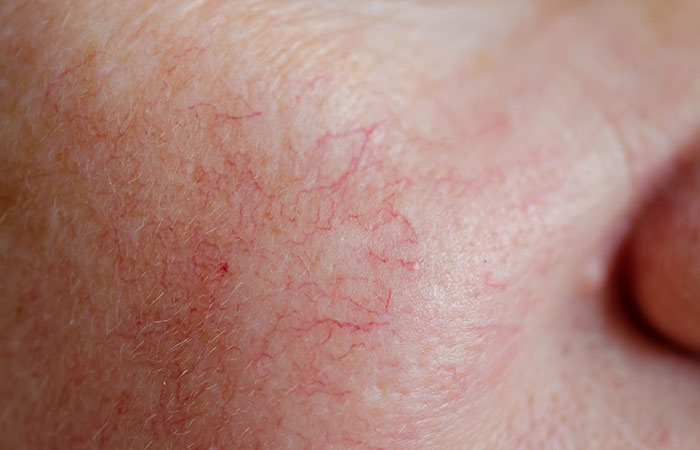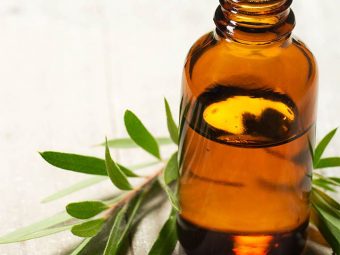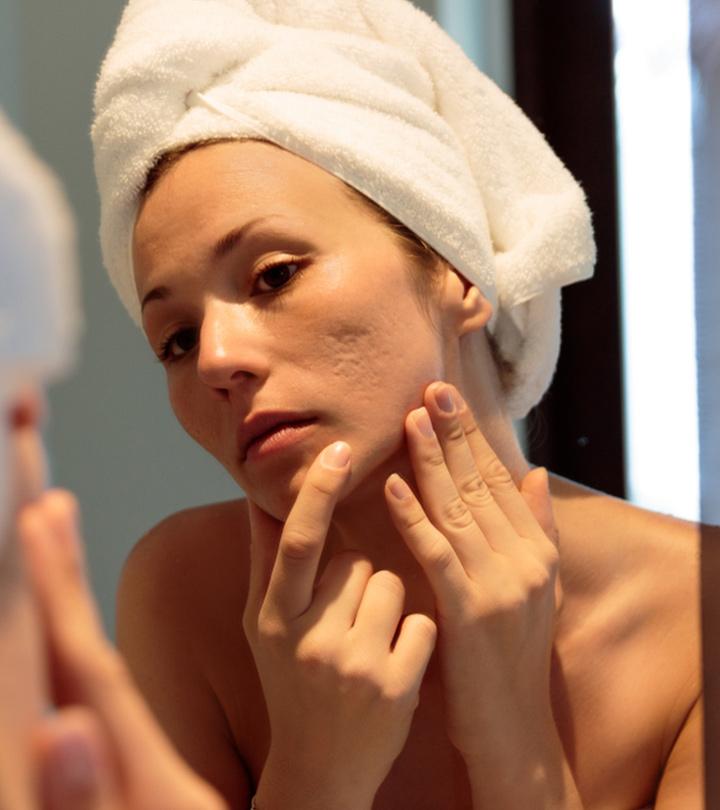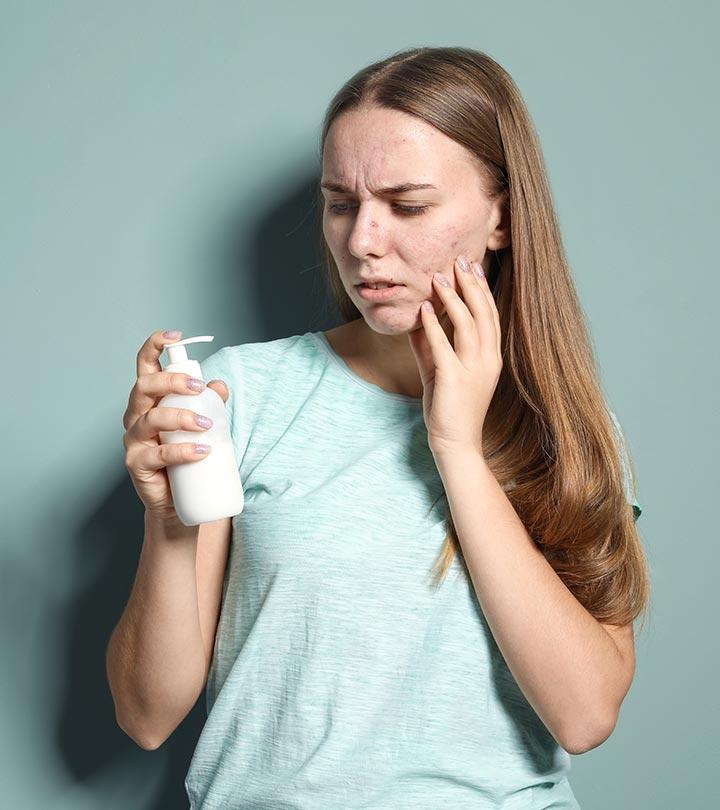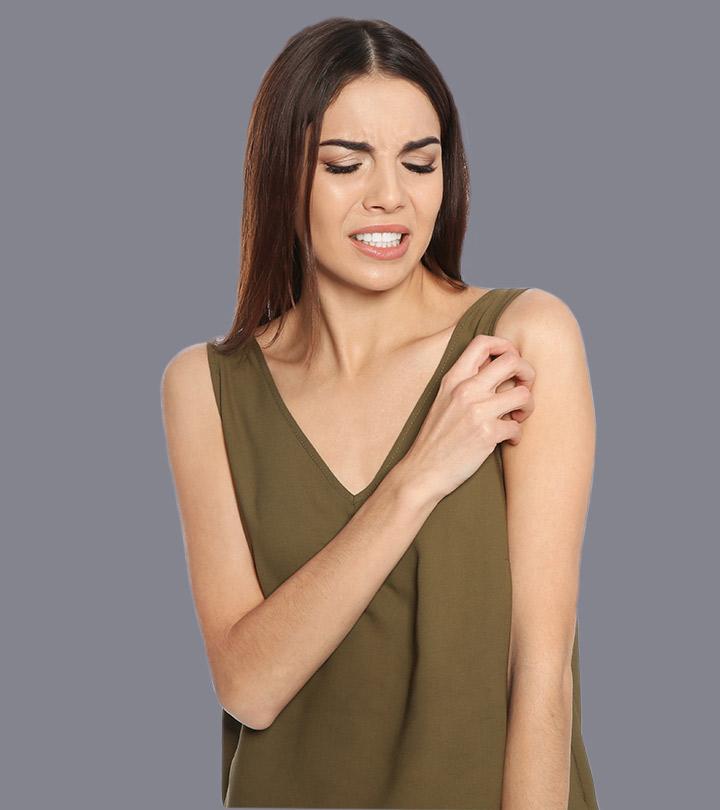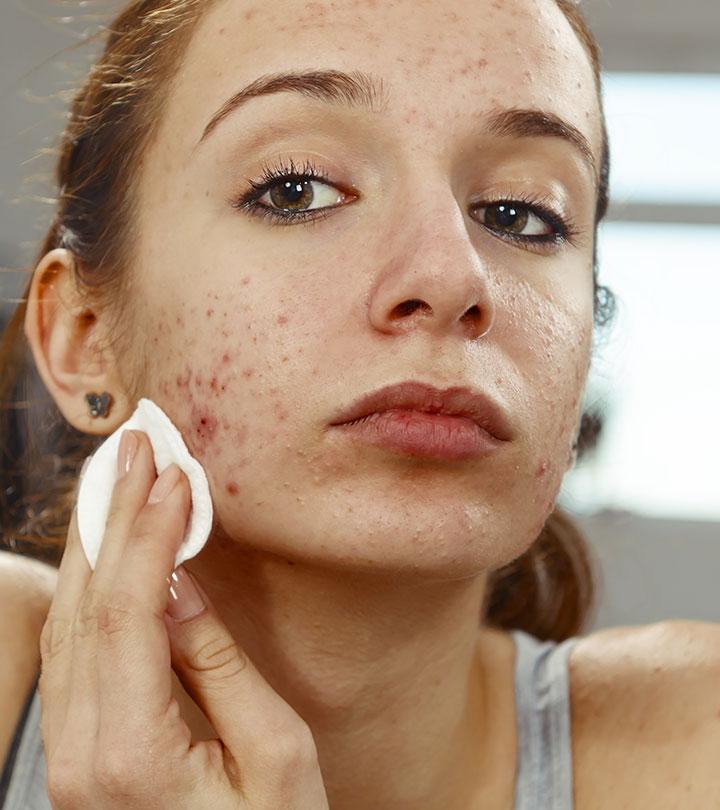6 Quick Ways To Get Rid Of Broken Capillaries On The Face
Banish the appearance of those spider veins on your skin and recover your confidence.

Image: iStock
Blood vessels beneath the skin enlarge, creating bright red tributaries in some face areas, resulting in broken capillaries. As they don’t look flattering, you might wonder how to get rid of broken capillaries on the face. Broken capillaries on the face usually occur around the lips, eyes, nose, legs, cheeks, and fingers in clusters.
While the exact reason behind this condition is not clear, it is a relief that broken capillaries are treatable. In this article, we discuss the symptoms, diagnosis, and treatment of broken capillaries on the face. Continue reading to know more about them.
In This Article
What Are Broken Capillaries?
This condition is also known as telangiectasia or spider veins. In this condition, the blood vessels right beneath your skin surface enlarge or widen, creating red, web-like threaded patterns on your skin.
They mostly appear in the areas around your lips, eyes, cheeks, nose, fingers, and legs. These usually appear in clusters. In most cases, broken capillaries on the face don’t affect your health. These are harmless unless caused by underlying health issues (we have discussed this later in the article). However, these patterns on your face can make you conscious about your appearance.
Let’s find out the reasons behind this condition.
What Causes Broken Capillaries Or Blood Vessels On Your Face?
The exact cause of broken capillaries or telangiectasia is unclear.
However, several factors may cause broken capillaries. They include:
- Aging (blood vessels are weakened with age)
- Skin trauma (inflammation or bruises may cause broken capillaries)
- Genetic factors
- Excessive exposure to the sun and wind (damages the blood vessels and bring them close to the surface)
- Side effects of medicines (may enlarge the venules)
- Side effects of topical or oral corticosteroidsi XA class of anti-inflammatory medicines used to provide relief from rashes, asthma, inflammatory bowel disease, and other conditions. (result in skin thinning and broken capillaries)
- Pregnancy (increased pressure on venules)
- Surgery
- Acne
- Excessive alcohol consumption (affects blood flow and causes liver issues)
During pregnancy, your chances of getting broken capillaries increase. The growing fetus puts excessive pressure on the blood vessels, breaking them. Hormonal therapy or taking birth control pills may also cause broken capillaries on the face.
You may also inherit the condition. It is called Hereditary Hemorrhagic Telangiectasia (HHT). Five genes are suspected to cause this issue, and only three out of five could be identified. Only 1% of people inherit this condition.
Apart from these causes, telangiectasia or broken capillaries can be a symptom of underlying health conditions. These include:
- Bloom Syndrome (a rare genetic condition. Broken capillaries are one of its symptoms.)
- Liver disease
- Nevus Flammeus or Port-Wine Stain (large patch of skin discoloration caused by capillary malformation)
- Ataxia Telangiectasia (a rare inherited condition of body systems)
- Osler-Weber-Rendu Syndrome or Hereditary Hemorrhagic Telangiectasia
- Klippel-Trenaunay-Weber Syndrome (a condition combining Port-Wine Syndrome and varicose veins)
- Rosacea (a chronic skin condition)
- Xeroderma Pigmentosum (a rare condition that increases UV sensitivity of the skin and eyes)
- Spider Angioma (the blood vessels get collected closer to the skin surface)
- Sturge-Weber syndrome (a disorder affecting the nervous system)
 Quick Tip
Quick TipConditions that affect your connective tissues may also cause broken capillaries. They include lupusi XA chronic, autoimmune medical disorder that leads to a hyperactive immune system that attacks healthy tissues and organs. , dermatomyositisi XA rare long-term inflammatory medical condition marked by muscle weakness and a distinctive violet or dusky red skin rash. , and sclerodermai XA rare chronic autoimmune disease that involves hardening and tightening of the skin and other body tissues. .
According to the American Academy of Dermatology (AAD), it is estimated that 16 million Americans are affected by rosacea and 50 million Americans are affected by acne every year. It was further estimated that 85% between 12 to 24 experienced mild acne and 15% of adult women experienced acne.
Broken Capillaries: Symptoms And Diagnosis
Broken capillaries are easily visible on your skin. The symptoms include:
- Fine, thread-like lines
- A web-like network of red lines
- Can be reddish, purple or bluish
- May cause itching and pain
- Measures between 1-3 mm
- Commonly found on chin, nose, cheeks
 Quick Tip
Quick TipThe red thread-like patterns on your skin surface make this condition easy to diagnose. However, doctors may also conduct clinical tests to determine if any underlying health condition caused broken capillaries. They might conduct the following tests:
- CT scan
- MRI
- X-rays
- Liver function tests
- Blood tests
They may also conduct other related tests to detect any abnormalities. Depending on the diagnosis, they will treat your condition.
How To Treat Broken Capillaries On The Face? Do Home Remedies Work?
Telangiectasia cannot be cured. However, you can treat it. The treatment mostly depends on the diagnosis. If rosacea is causing broken capillaries, the doctor will try to treat rosacea to minimize the appearance of broken capillaries.
Not all treatments work for everyone with broken capillaries. Hence, it is better to consult a doctor to find out which treatment method is suitable for you. Here are the treatment options for broken capillaries:
1. Topical Retinoids
Retinoids are used to treat many skin issues and can reduce the visibility of the capillaries. However, be careful as retinoids might cause redness and itching.
2. Laser Therapy
Doctors use lasers to destroy the damaged capillaries. This might involve a little bit of pain and discomfort and may also cause skin damage initially. However, your skin recovers quickly.
3. Sclerotherapy
In this process, the doctor injects sclerosing agents to seal the visible vessels and make them disappear. While this process can be painful for a few, not everyone experiences discomfort and pain. The recovery period is short.
4. Intense Pulsed Light (IPL)
This therapy is similar to laser therapy. However, the lasers used in IPL penetrate deep into your skin layers without causing any damage.
In addition to these treatments, there are some commonly used home remedies to manage broken capillaries on the face.
5. Horse Chestnut
Horse chestnut has been used as an herbal remedy to treat chronic venous insufficiency, a condition characterized by poor blood flow, which causes swelling, pain, itching, and broken capillaries (2). Using products containing horse chestnut may help improve circulation and improve the appearance of broken capillaries on the face.
6. Arnica Oil
Arnica oil has been used as an herbal remedy in treating post-operative pain. It may also help with pain following varicose vein surgery (3). This may hint at the oil’s potential of treating broken capillaries.
Clare, a blogger, accidentally discovered that tea tree oil may help diminish spider veins. She writes, “My mom had spider veins, so I’m assuming I have them because she did. I started using tea tree oil because I was having a really bad break out that I wanted to control… I noticed after using it a week that my spider veins started to diminish. They haven’t gone all together by all means, but they certainly are much less noticeable than before (i).”
It is important to note that research on these ingredients is limited and there is a lack of concrete evidence to establish whether or not natural remedies or ingredients can minimize the appearance of broken capillaries. However, you may take care of your skin at home and follow these measures to prevent aggravating the condition any further:
- Avoid Washing Your Face With Hot Water
Hot water can further damage your blood vessels. Even if you are using warm water, be gentle when using it on your face.
- Use Cold Compress
Be it a bag of frozen peas or an ice pack, it can provide great relief. Right after sun exposure, apply a cold compress to prevent the appearance of broken capillaries.
- Massage With Aloe Vera
Aloe vera has skin-soothing effects. Although it may not help with broken capillaries, it might help in soothing other skin issues, such as rosacea, and reducing redness (1). If your broken capillaries are a result of rosacea, aloe vera gel might help.
- Minimize Sun Exposure
Avoid exposing your skin to the harmful UV rays during the peak hours. Always use good SPF (sun protection factor) sunscreen and cover yourself up properly if you are going out.
- Control Your Alcohol Consumption
Drink in moderation. Consult a doctor and inquire if it is okay if you drink in moderation or you need to quit completely.
This is a common skin issue, and anyone can get it. However, certain factors make a few people vulnerable to broken capillaries.
Risk Factors
The following reasons may increase your chances of developing broken capillaries on your face:
- Pregnancy
- Exposure to the sun
- Alcohol abuse
- Aging
- Skin issues, such as rosacea, scleroderma, and dermatomyositis
- Corticosteroids
Infographic: How to Get Rid of Broken Capillaries On The Face
The spidery veins that run beneath the skin are a matter of concern. Broken capillaries appear on the face, leg, and fingers. Spider veins are caused due to enlargement of the blood vessels, but they are mostly harmless and are more a cause of aesthetic concern. This condition may be caused due to aging, trauma to the skin, genetic factors, pregnancy, surgery, or acne. Certain diseases also lead to broken capillaries. Scroll to the infographic below to understand the standard treatment options for broken capillaries.

Illustration: StyleCraze Design Team
Skin trauma and injuries may cause broken capillaries, which may go away once the injury heals. However, if it is genetic, it might be impossible to get rid of broken capillaries, and you may require frequent treatment to manage the condition. You must consult a doctor or a dermatologist as the course of treatment depends on the causative factors. Also, follow the tips discussed in the article to manage broken capillaries and soothe your skin at home. Avoid excessive sun exposure, alcohol consumption, and use warm water on your skin. These small steps and proper treatment may help you minimize the appearance of broken capillaries. By adopting a healthy lifestyle (like a balanced diet, proper hydration and regular exercises), and taking appropriate skincare measures, you can promote healthy and radiant skin.
Frequently Asked Questions
Can broken capillaries heal on their own?
Broken capillaries caused by injury or trauma can heal on their own, while broken capillaries caused by aging, loose skin, hormones, or medical issues may not heal completely.
Does vitamin K cream help with broken capillaries?
Anecdotal research suggests that applying vitamin K facial creams to bruises and broken capillaries can help them recover more quickly.
Can makeup or skincare products cover up broken capillaries on the face?
Yes, while makeup may not aid in reducing the appearance of broken capillaries, it can help cover them up. Try using a full-coverage foundation with a color-corrector to conceal them.
Are there any foods or supplements that can help prevent or treat broken capillaries on the face?
Yes, anecdotal evidence suggests the consumption of vitamin C supplements and eating vitamin K-rich foods like spinach and broccoli may aid in preventing broken capillaries.
Infographic: Tips To Prevent Broken Capillaries On The Face
Broken capillaries underneath the skin surface can make your face look red in patches. However, there are several ways you can prevent that splotchy look, and that is what this infographic is all about.
Check out the illustration below to get tips on ways to use beauty and skin care products to prevent broken capillaries, which drinks to avoid, and various protective measures. Illustration: StyleCraze Design Team
Key Takeaways
- Broken capillaries occur when the blood vessels beneath the skin surface widen, causing red, thread-like patterns on the skin.
- Genetic traits, aging, certain medications, pregnancy, or some underlying health condition can cause spider veins.
- Topical retinoids and laser therapy can be used to treat broken capillaries.
- You can prevent its aggravation by using cold compresses or limiting sun exposure.

Image: Stable Diffusion/StyleCraze Design Team
Say goodbye to broken capillaries on your face! Click on this informative video to learn about effective techniques and tips for reducing and eliminating broken capillaries for flawless skin.
Personal Experience: Source
StyleCraze's articles are interwoven with authentic personal narratives that provide depth and resonance to our content. Below are the sources of the personal accounts referenced in this article.
i. How tea tree oil diminished my spider veinshttps://claresbeauty.wordpress.com/2015/01/24/how-tea-tree-oil-diminished-my-spider-veins/
References
Articles on StyleCraze are backed by verified information from peer-reviewed and academic research papers, reputed organizations, research institutions, and medical associations to ensure accuracy and relevance. Read our editorial policy to learn more.
- Update on the management of rosacea, Clinical, Cosmetic and Investigational Dermatology, US National Library of Medicine, National Institutes of Health.
https://www.ncbi.nlm.nih.gov/pmc/articles/PMC4396587/ - Horse chestnut seed extract for chronic venous insufficiency The Cochrane Database of Systematic Reviews US National Library of Medicine National Institutes of Health.
https://www.ncbi.nlm.nih.gov/pmc/articles/PMC7144685/ - Clinical Trials Potential Mechanisms and Adverse Effects of Arnica as an Adjunct Medication for Pain Management Medicines US National Library of Medicine National Institutes of Health.
https://www.ncbi.nlm.nih.gov/pmc/articles/PMC8537440/







